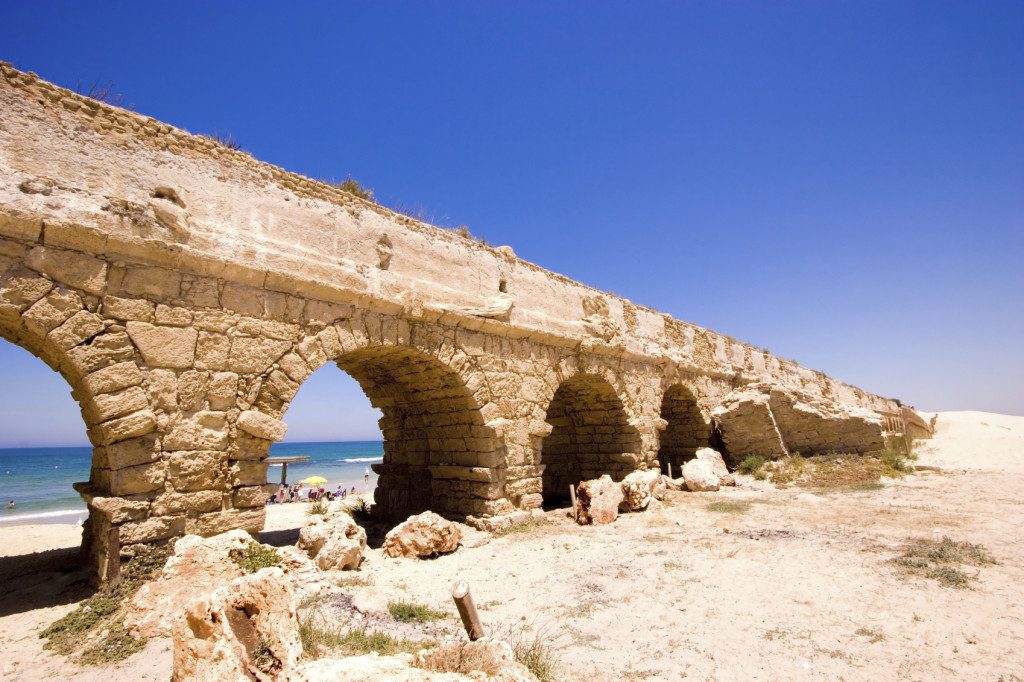Ancient Aqueducts Still Visible in Israel Today
September 24th 2019
Ancient aqueducts are ubiquitous throughout the Holy Land yet if you don’t know where to look, they are easy to miss. These man-made water supply channels were developed throughout different eras in Israel’s history, from the
Iron age through to the Hellenistic period and most notably, the period of Roman rule, when the systems were perfected.
There are aqueducts, in one form or another, in nearly every part of the country. One you’ll see if you tour the Western Wall tunnels is a Hasmonean period aqueduct connected to an ancient underground water reservoir. Whether beneath the ground or above, these constructions provide a fascinating insight into human history, resilience, and ingenuity.
Other ancient Israeli aqueducts we recommend you see include those found in the following locations.
Caesarea
Perhaps the most famous and impressive aqueduct in Israel is found near the ancient port city of Caesarea. It was constructed by Herod the Great two thousand years ago to bring extra water to the growing city from springs ten kilometers away. A second parallel aqueduct was built a few centuries later by the Romans.
The raised aqueducts of Caesarea, with their iconic arches, can be seen in a number of places today, in remarkably good condition. One of these places is on a stunningly beautiful beach a short distance from the old Caesarea. It’s a great place to take photographs.
Akko
A few kilometers north of Akko (or Acre), in Kibbutz Lochamei-Hagetaot, are the remains of an old aqueduct that supplied water to the port city from the springs of Cabri, 14 kilometers away. It was built by the Ottomans in a raised open canal format. Today, while unused, it provides a stunning architectural feature across the local landscape.
A number of ancient aqueducts flowed from Cabri over the millennia, few of which survive to this day and are mainly underground.
The Zippori National Park
Six kilometers north of Nazareth lie the ancient ruins of Zippori. Once a thriving Jewish city, it is now an archeological site of interest situated in the Zippori National Park in the Lower Galilee. It was home to Rabbi Judah HaNasi, compiler of the Mishnah, as well as the location of the great Jewish court known as the Sanhedrin.
Today, you can explore numerous beautiful ancient mosaics, for which the park is most famous, as well as the remains of synagogues, mansions, a Roman theater, burial caves, a water reservoir and aqueduct, and a crusader fortress.
Tel Megido
In the Lower Galilee is the site of the ancient city of Megiddo (known in Greek as Armageddon). Due to its strategic location and elevated position, Megiddo was an important fortification and royal city in the Kingdom of Israel. Today, visitors can view the remains of this significant biblical city which was designated a UNESCO World Heritage Site.
The excavated site includes a fascinating secret underground aqueduct that transported water from a nearby spring, allowing the city’s inhabitants to survive long military sieges.
The Qumran National Park
When visiting the Qumran National Park, you’ll come across a rather non-descript rocky winding trackway. What at first sight might seem like a pathway is in fact an ancient aqueduct, built sometime in the Hellenistic or early Roman period. It diverted water from a nearby brook and filled cisterns via an elaborate network of channels.
The national park, which is situated on the northwestern shore of the Dead Sea, is most famous for being where the Dead Sea Scrolls were discovered. The remains of the ancient settlement of Qumran are still visible.












